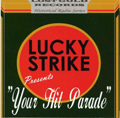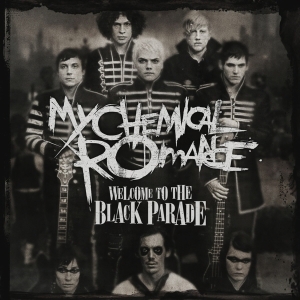Related Research Articles

In popular music, a cover version, cover song, remake, revival, or simply cover, is a new performance or recording by a musician other than the original performer or composer of the song. Originally, it referred to a version of a song released around the same time as the original in order to compete with it. Now, it refers to any subsequent version performed after the original.
A hit parade is a ranked list of the most popular recordings at a given point in time, usually determined either by sales or airplay. The term originated in the 1930s; Billboard magazine published its first music hit parade on January 4, 1936. It has also been used by broadcast programs which featured hit tunes such as Your Hit Parade, which aired on radio and television in the United States from 1935 through the 1950s.

Your Hit Parade was an American radio and television music program that was broadcast from 1935 to 1953 on radio, and seen from 1950 to 1959 on television. It was sponsored by American Tobacco's Lucky Strike cigarettes. During its 24-year run, the show had 19 orchestra leaders and 52 singers or groups. Many fans inaccurately referred to the show as The Hit Parade.

The Soft Parade is the fourth studio album by American rock band the Doors, released on July 18, 1969, by Elektra Records. Most of the album was recorded following a grueling tour during which the band was left with little time to compose new material. Record producer Paul A. Rothchild recommended a total departure from the Doors' first three albums: develop a fuller sound by incorporating brass and string arrangements provided by Paul Harris. Lead singer Jim Morrison, who was dealing with personal issues and focusing more on his poetry, was less involved in the songwriting process, allowing guitarist Robby Krieger to increase his own creative output.
The CHUM Chart was a Canadian hit parade that consisted of 50 top tunes from May 1957 to July 1968, but in August 1968, the top 50 song list was reduced to 30 top songs until the final hit parade was issued in June 1986. Furthermore, CHUM was a Toronto, Ontario radio station of which the call letters were CHUM AM, from 1957 to 1986, and was the longest-running Top 40 chart in the world produced by an individual radio station. On January 10, 1998, sister station CHUM-FM, which airs a hot adult contemporary format, revived the CHUM Chart name for a new countdown show.
Hit Parader was an American music magazine that operated between 1942 and 2008. A monthly publication, it focused on rock and pop music in general until the 1970s, when its focus began turning to hard rock and heavy metal. By the early 1980s, Hit Parader focused exclusively on heavy metal and briefly produced a spinoff television program entitled Hit Parader's Heavy Metal Heroes. The magazine reached its circulation peak in the mid-to-late 1980s selling a half-million copies every month as heavy metal music achieved high levels of popularity and commercial success.

"Welcome to the Black Parade" is a song by American rock band My Chemical Romance, from their third studio album The Black Parade (2006). It was released on September 12, 2006, as the album's lead single, with the studio version available on the band's Myspace on September 2, 2006. The music video for the single was recognized as MTV's "Greatest Music Video of the Century" in 2017. The song topped the UK Singles Chart, reached number nine on the US Billboard Hot 100 and was named one of the Rock and Roll Hall of Fame's Songs That Shaped Rock and Roll.

Hit Parade of 1943 also known as Change of Heart is a 1943 American musical film made by Republic Pictures. It was directed by Albert S. Rogell and produced by Albert J. Cohen from a screenplay by Frank Gill Jr. and Frances Hyland.
Ö3 Austria Top 40 is the official Austrian singles chart, as well as the radio show which presents it, aired Tuesdays on Hitradio Ö3. The show presents the Austrian singles, ringtones and downloads chart. It premiered on 26 November 1968 as Disc Parade and was presented by Ernst Grissemann.

32 Minutes and 17 Seconds with Cliff Richard is the fifth studio album by Cliff Richard and was released in September 1962. The album reached #3 on the UK Albums Chart. The album contains 14 songs, six with the Shadows and eight with the Norrie Paramor Orchestra.